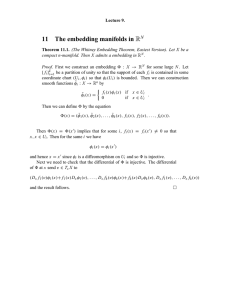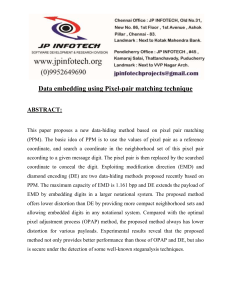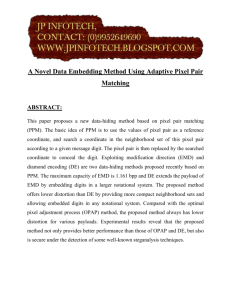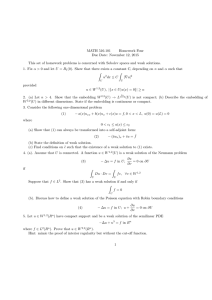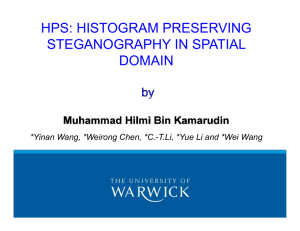www.ijecs.in International Journal Of Engineering And Computer Science ISSN:2319-7242
advertisement
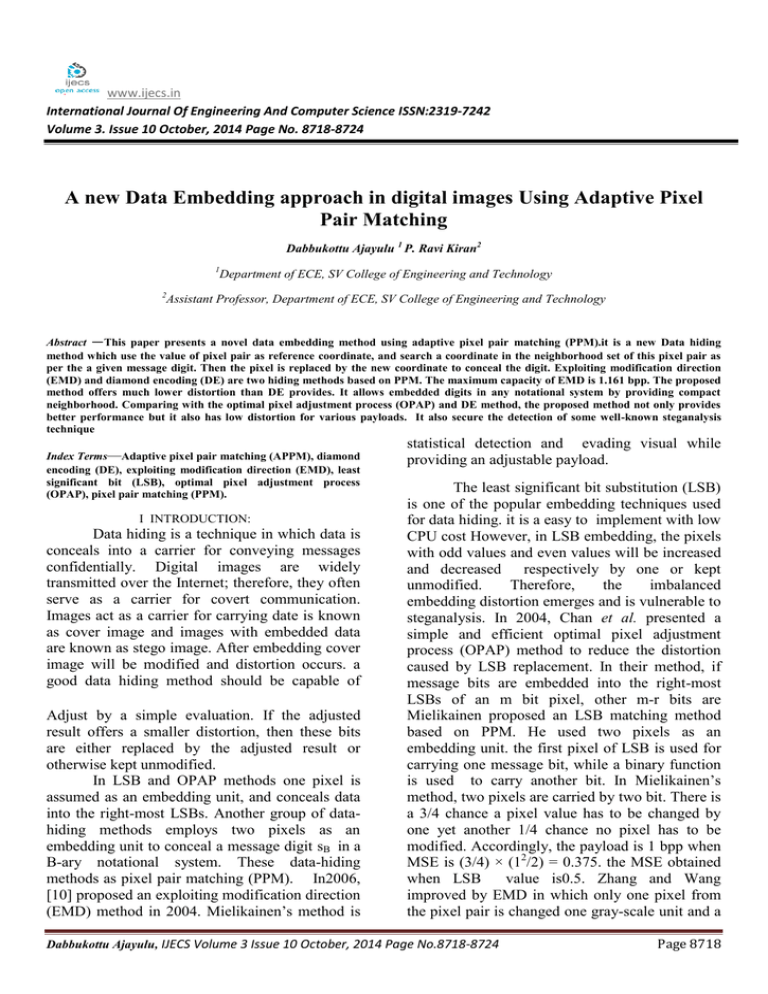
www.ijecs.in
International Journal Of Engineering And Computer Science ISSN:2319-7242
Volume 3. Issue 10 October, 2014 Page No. 8718-8724
A new Data Embedding approach in digital images Using Adaptive Pixel
Pair Matching
Dabbukottu Ajayulu 1 P. Ravi Kiran2
1
Department of ECE, SV College of Engineering and Technology
2
Assistant Professor, Department of ECE, SV College of Engineering and Technology
Abstract —This paper presents a novel data embedding method using adaptive pixel pair matching (PPM).it is a new Data hiding
method which use the value of pixel pair as reference coordinate, and search a coordinate in the neighborhood set of this pixel pair as
per the a given message digit. Then the pixel is replaced by the new coordinate to conceal the digit. Exploiting modification direction
(EMD) and diamond encoding (DE) are two hiding methods based on PPM. The maximum capacity of EMD is 1.161 bpp. The proposed
method offers much lower distortion than DE provides. It allows embedded digits in any notational system by providing compact
neighborhood. Comparing with the optimal pixel adjustment process (OPAP) and DE method, the proposed method not only provides
better performance but it also has low distortion for various payloads. It also secure the detection of some well-known steganalysis
technique
Index Terms—Adaptive pixel pair matching (APPM), diamond
encoding (DE), exploiting modification direction (EMD), least
significant bit (LSB), optimal pixel adjustment process
(OPAP), pixel pair matching (PPM).
I INTRODUCTION:
Data hiding is a technique in which data is
conceals into a carrier for conveying messages
confidentially. Digital images are widely
transmitted over the Internet; therefore, they often
serve as a carrier for covert communication.
Images act as a carrier for carrying date is known
as cover image and images with embedded data
are known as stego image. After embedding cover
image will be modified and distortion occurs. a
good data hiding method should be capable of
Adjust by a simple evaluation. If the adjusted
result offers a smaller distortion, then these bits
are either replaced by the adjusted result or
otherwise kept unmodified.
In LSB and OPAP methods one pixel is
assumed as an embedding unit, and conceals data
into the right-most LSBs. Another group of datahiding methods employs two pixels as an
embedding unit to conceal a message digit sB in a
B-ary notational system. These data-hiding
methods as pixel pair matching (PPM). In2006,
[10] proposed an exploiting modification direction
(EMD) method in 2004. Mielikainen’s method is
statistical detection and evading visual while
providing an adjustable payload.
The least significant bit substitution (LSB)
is one of the popular embedding techniques used
for data hiding. it is a easy to implement with low
CPU cost However, in LSB embedding, the pixels
with odd values and even values will be increased
and decreased respectively by one or kept
unmodified.
Therefore,
the
imbalanced
embedding distortion emerges and is vulnerable to
steganalysis. In 2004, Chan et al. presented a
simple and efficient optimal pixel adjustment
process (OPAP) method to reduce the distortion
caused by LSB replacement. In their method, if
message bits are embedded into the right-most
LSBs of an m bit pixel, other m-r bits are
Mielikainen proposed an LSB matching method
based on PPM. He used two pixels as an
embedding unit. the first pixel of LSB is used for
carrying one message bit, while a binary function
is used to carry another bit. In Mielikainen’s
method, two pixels are carried by two bit. There is
a 3/4 chance a pixel value has to be changed by
one yet another 1/4 chance no pixel has to be
modified. Accordingly, the payload is 1 bpp when
MSE is (3/4) × (12/2) = 0.375. the MSE obtained
when LSB
value is0.5. Zhang and Wang
improved by EMD in which only one pixel from
the pixel pair is changed one gray-scale unit and a
Dabbukottu Ajayulu, IJECS Volume 3 Issue 10 October, 2014 Page No.8718-8724
Page 8718
message digit in a 5-ary notational system can be
embedded. Therefore, the payload is (1/2) log2
5=1.161 bpp. LSB matching and EMD methods
greatly improves the traditional LSB method in
which a improved stego image quality can be
achieved under the same payload. However, the
maximum payloads of LSB matching and EMD
are only 1 and 1.161 bpp, respectively. Hence,
these two methods are not suitable for applications
requiring high payload.
The embedding method of EMD and LSB
matching offers no mechanism to increase the
payload. In 2008, Hong [11] presented a hiding
method based on Sudoku solution to obtain a
maximum payload (1/2 log 2 9 bpp. In 2009 Chao
II RELATED WORK
DE increases the payload of EMD by embedding
digits in a B-ary notational system and OPAP
reduces the image distortion compared with
traditional LSB method. These two methods
provide a high payload while preserving an
acceptable stego image quality.
Diamond Encoding
et al [12] presented a diamond encoding (DE)
method used to improve the payload of EMD
(Exploiting modification direction) and employed
to generate diamond characteristic value (DCV).
According to the DCV’s neighborhood set
embedding is done to alter the pixel pairs in the
cover image. Chao used an embedding parameter
to control the payload, in which a digit in a B-ary
notational system can be concealed into two
pixels, where B=2k2+2k+1. If k=1, B=5, i.e. digits
in 5-ary notational notation system and the
resultant payload is equivalent to EMD. If k=2,
B=13, if k=3, B=25.
diamond function is then employed to calculate
The DCV of (x,y) where
After that, the coordinates belong to the
set ф(x,y) are searched and DE finds a coordinate
(x',y') satisfying f(x',y')=sB and then (x,y) is
replaced by (x',y') Repeat these procedures until
all the message digits are embedded. In the
extraction phase, pixels are scanned using the
same order as in the embedding phased. The DCV
value of a pixel pair (x',y') is then extracted as a
message digit.
Chao et al. proposed a DE method in 2009 based
on PPM. This method conceals a secret digit in a
B-ary notational system into two pixels,
where
. The payload of DE
is
bpp. Note that
when
, DE Equivalent to EMD in which
both methods conceal digits are in 5-ary notational
system. The DE method described as follows.
Let the size m the bits cover image be
M×M, message digits be , where the subscript
B represents SB is in a B-ary notational system.
First, the smallest integer is determined to satisfy
the following equation:
Where
denotes the number of
message digits in a B-ary notational system. To
conceal a message digit SB into pixel pair (x,y), the
neighborhood set
is determined by
Where ф(x,y) represents the set of the
coordinates' (a,b) whose absolute distance to the
coordinate (x,y) is smaller or equal to k. A
Fig.1. Diamond encoding patterns with k=1, k=2,
and k=3
Here is a simple example. Let k=3
, then
The neighborhood set ф (12,10) and
its corresponding DCV values are shown in Fig. 1.
If a digit in a 25-ary notational system 1425 needs
to be embedded, then in the region defined by
ф(12,10) .We find the value of DCV of
(x',y')=(11,12)=14 Therefore, we simply replace
and
Dabbukottu Ajayulu, IJECS Volume 3 Issue 10 October, 2014 Page No.8718-8724
Page 8719
(12,10) by (11,12) and the digit is embedded. To
extract the embedded digit,
result obtained as 14
which is an embedded digit
III,
ADAPTIVE
(APPM)
PAIR
PIXEL
MATCHING
The basic idea of the PPM-based datahiding method is to use pixel pair
as the
coordinate, and search for the neighbor coordinate
within a predefined neighborhood set
ф(x,y) such that
where f is the
extraction function and is the message digit in a
B-ary notational system to be concealed. Data
embedding is done by replacing (x, y) with (x',y').
In PPM-based method, suppose a digit
is to be kept secret then the range
values lies
between 0 and B-1,and coordinate has
has to be found such that
Therefore, the range of
should lies
between 0 and B-1, and each integer should occur
at least. In the addition process, to reduce the
distortion, the number of coordinates
in
should be small. The best PPM method shall
satisfy the following requirements: 1) There
should be exactly B coordinates in
2)
The values of extraction function in these
coordinates are mutually exclusive. 3) The design
The value of
significantly
affect the stego image quality. The design of
must satisfy: all the values of
and the summation of the
squared distances between all coordinates in
has to be the smallest because in
embedding
one of the coordinate is replaced
by
. Let there are B coordinates in ф(x,y)
i.e., digits in a B-ary notational system are to be
kept secret, and the probability of replacing( x,y)
by one of the coordinates in ф(x,y) is equivalent.
The average of MSE can be obtained by averaging
the summation of the squared distance between
and other coordinates in
Thus,
given a
after embedding the expected
MSE can be calculated by
MSEф(x,y) =
-
2
+( -y)2)
Here we will propose an adaptive pixel
pair matching (APPM) data-hiding method to
provide better
so that MSE get
minimized. Data is then embedded by using PPM
based on this f(x, y) and
Let
of ф(x,y) and f(x,y) should be capable of
embedding digits in any notational system so that
the B must be selected proper to achieve lower
embedding distortion.
DE greatly improves the payload of EMD
while preserving acceptable stego image quality.
However, there are several issues. First, the
payload of DE is determined by the selected
notational system, which is restricted by the
parameter; itself therefore, the notational system
cannot be arbitrarily selected. For example, when
is 1, 2, and 3, then digits in a 5-ary, 13-ary, and
25-ary notational system are used to embed data,
respectively. However, DE will not support the
embedding digits in a 4-ary (i.e., 1 bit per pixel) or
16-ary (i.e., 2 bits per pixel) notational system.
Second, in
Diamond shape is defined by
DE, which may have some unnecessary distortion
when
. In fact, it is better other than diamond
shape resulting in a smaller embedding distortion
In section III-A we redefine ф(x,y) and f(x,y)
based on that a new embedding method is
proposed on PPM. The proposed method allows
concealing digits in any notational system, and
provides the even or same smaller embedding
distortion than DE for various payloads.
A. Extraction function and neighbor set.
f(x,y) =(x + cB × y) mod B
The solution of
optimization problem
Minimize:
–
is a discrete
Subject to: f (xi ,yi) є {0,1……..,B-1}
f (xi , yi)
f(
for
) , if i
(1)
Given B is a integer and (x, y) integer pair, (1) can
be solved to obtain a constant
and B pairs of
(xi, yi). These B pairs of
are denoted by
are
denoted
by
Note
that
represents a neighborhood set of
Table I lists the constant
satisfying (1)
for the payloads under 3 bpp. For a given B, it is
possible
to
have
more
than
one
satisfying (1). Table I only lists the
smallest .
Fig. 2 shows some representation of
and their corresponding
satisfying (1),
where the center
is shaded with lines.
Note that, in DE, assuming k=3 and k=4,
respectively, embeds digits in the 25-ary and 41-
Dabbukottu Ajayulu, IJECS Volume 3 Issue 10 October, 2014 Page No.8718-8724
Page 8720
ary notational systems. We also depict the ф(x, y)
of DE when setting k=3 and k=4 in Fig. 2.
TABLE I
LIST OF THE CONSTANT
Fig. 2.
APPM
FOR
Neighborhood set( shaded region) for
The four corners of the diamond shape cause
larger MSE but we selects more compact region
for embedding, and thus less distortion can be
obtained.
B. Embedding Procedure:
Let the cover image is of size
, S is
the message bits to be concealed and the size of S
is . First we calculate the minimum value of B
so that all the message bits can be embedded.
Then, message digits are linearly concealed into
pairs of pixels. The brief procedure is listed as
follows.
Input: Cover image I of size
conceal bit
stream S, and key Kr.
Output: Stego image I', CB фB (x,y) and Kr .
1. Calculate the minimum B satisfying
/2 B│ and Convert S into B-ary notational
system SB.
2. Solve the discrete optimization to find CB
and
.
3. In the region
record the coordinate ( i
, i). Such that f( i , i) = i,
4. Construct a non repeating random embedding
sequence Q using a key Kr.
5. To embed a message digit SB, two pixels (x,y)
in the cover image are selected with respect of
embedding sequence Q, and
calculate the
modulus distance [14]
–
Between
then replace (x,y) with
d
,
.
d
6. Repeat the above 5 steps until all the message
digits get embedded.
In real time applications, we can solve all
and
at once. With the knowledge of
and
, there is no need to perform Step
2.
Let
d and
d. If an
overflow or underflow problem occurs, that is,
then in the
neighborhoods of
. Find a nearest
such that
.This can be obtained by
solving the optimization problem.
2
2
Minimize
Subject to
,
We use a simple example to illustrate the
embedding procedure. Let the cover image of size
512 × 512 with embedded requirement of 520 000
bits. The minimun B satisfying
bits.
The minimun
satisfying
is 16; therefore , we choose the 16-ary
notational system as the embedding base. After
the notational system is known,
and
can be obtained by solving(1). The 16 i
,
in ф16 (0,0) such that
i, i
are recoded. The neighbour set ф16(0.0) such that
, are shown in Fig. 3.
I , i , where
suppose a pixel pair (10,11) that is to be conceal a
digit
in 16-ary notational system. The
modulus should lies between
I and
is
and
5 ,
5)
; therefore, we replace (10,11) by (101,11+1) = (9,12).
C. Extraction Procedure
To obtained the embedded message digits,
pixel pairs are scanned in the same order as in the
embedding procedure. The message digits the
values of extraction function of the pixel pair.
Input: stego image
,
and Kr.
Output: secret bit stream
1. Construst the embedding sequence using the
key Kr.
Dabbukottu Ajayulu, IJECS Volume 3 Issue 10 October, 2014 Page No.8718-8724
Page 8721
2. Select two pixels (x', y') from the embedding
sequence Q.
3. Calculate
the result is the embedded
digit.
4. Repeat the above step 2 and step 3 until the
message digits are extracted.
5. The message bits can be obtained by
converting the extracted message digits into a
binary bit stream.
From the above example. Consider the
scanned pixel pair be
The
embedded digits in 16-ary notational system can
be extract by calculating
12mod 16=I16.
MSEOPAP
(3)
Note that when r=1, OPAP and LSB have the
same value of MSE. In other words, OPAP cannot
reduce the distortion caused by LSB embedding at
1 bpp.
In DE method, consider that the
probability of selecting a coordinate ,
in the
diamond shape
to replace the pixel pair
is the same. Therefore, the average MSE on
embedding digits in a B-ary notational system is
IV.
QUALITY
ANALYSIS
AND
EXPERIMENTAL RESULT
Image distortion generally occurs when
data is embedded because the pixel value is
modified. We use MSE to measure the image
quality
denotes the image size,
represents the pixel value of the original
image and the stego image, A smaller MSE
denotes that the stego image has better image
quality.
A. Analysis of Theoretical MSE:
=
(4)
Where
In this section we exmain the average of MSE
of LSB. OPAP, DE and APPM so that the stego
imagequality obtain from each method can be
theoritically measured. When data are embedded
using r LSBs of each pixel, each bit value 0 or 1
has equal probaality. The squared error caused by
embedded bit in the LSB is
;
therfore the average MSE of embeddeding r LSB
is given by
LSB
(2)
Now we analyse the average MSE of
OPAP when r message bits are embedded in every
pixel. suppose the original pixel value be υ and
the stego pixel value be υ". then the probablity of
or
is 1/2r; the
probability of
to be within the range
r
is 1/2 . Therefore , the average MSE
caused by embeddimg r bits is
Fig.4. Calculation of
averaged MSE for APPM with
the
theoretical
where k is the embedding parameter of
DE. For embedding digits in a B-ary notational
system using APPM, assume that the probablity of
replacing
with each
in
is
identical. With the knowledge of
, the
average MSE can be ovtained by
MSEAPPM =
for
)
)
(5)
For example, the
(x,y) that allows
conceal digits with the 16-ary notational system is
shown in Fig.4. The squared of the distance
between
and the center
position in
are marked in the
corresponding positions. The average MSE is then
estimated as average square distance
MSE
APPM (B=16)
4+5×3
Dabbukottu Ajayulu, IJECS Volume 3 Issue 10 October, 2014 Page No.8718-8724
=
Page 8722
LSB and OPAP applied in every pixel of
the cover image as an embedding unit, r bit can be
embedded into each pixel. Therefore, the payload
is r bpp. For the PPM-based embedding method, a
payload with r bpp is equal to embedding 2r bits
for every two pixel , which is equal to concealing
digits in a -ary notational system. Because DE
does not allow embedding digits exactly in a
ary notational system. We campare the MSE of
APPM with OPAP and LSB first. The result are
depicted in Table II. Note that the result listed in
the Table II are obtained by using (2)-(5), i.e. the
theoretically value of MSE. A similar result can
also be obtained if these method is applied in
nature images.
Stego Image
BY USING DIAMOND ENCODING
Stego image
SIMULATION RESULTS:
Original Image
BY USING LSB
Stego image
ADAPTIVE PIXEL PAIR MATCHING
Stego image
BY USING OPAP
Methodology
LSB
OPAP
Diamond Encoding
APPM
BER
0
0
0
0
MSE
5.1285
2.6659
2.0417
1.3123
V CONCLUSION
Dabbukottu Ajayulu, IJECS Volume 3 Issue 10 October, 2014 Page No.8718-8724
Page 8723
This paper proposed a simple and effectual
data embedding method based on PPM. Two
pixels are scanned as a embedding unit and a
specially designed neighbor set is employed to
embed message digits with a smallest notational
system. APPM allows users to select digits in any
notational system for data embedding for
achieving better image quality. The proposed
method provides a lower distortion than DE. The
proposed method resolves the low payload
problem in EMD. It provides smaller MSE as
compared with OPAP and DE. APPM does not
produce artifacts in stego images and steganalysis
results are similar to those of the cover images. It
provides secure communication under the
detection of some well-known steganalysis
techniques.
REFERENCES
[8] C. K. Chan and L. M. Cheng, “Hiding data in
images by simple LSB substitution,” Pattern
Recognit., vol. 37, no. 3, pp. 469–474, 2004.
[9] J. Mielikainen, “LSB matching revisited,”
IEEE Signal Process. Lett., vol. 13, no. 5, pp.
285–287, May 2006.
[1] J. Fridrich, Steganography in Digital Media:
Principles, Algorithms, and Applications.
Cambridge, U.K.: Cambridge Univ. Press, 2009.
[2] N. Provos and P. Honeyman, “Hide and seek:
An introduction to steganography,” IEEE Security
Privacy, vol. 3, no. 3, pp. 32–44, May/Jun. 2003.
[3] A. Cheddad, J. Condell, K. Curran, and P.
McKevitt, “Digital image steganography: Survey
and analysis of current methods,” Signal Process.,
vol. 90, pp. 727–752, 2010.
[4] T. Filler, J. Judas, and J. Fridrich, “Minimizing
embedding impact in steganography using trelliscoded quantization,” in Proc. SPIE, Media
Forensics and Security, 2010, vol. 7541, DOI:
10.1117/12.838002.
[5] S. Lyu and H. Farid, “Steganalysis using
higher-order image statistics,” IEEE Trans. Inf.
Forensics Security, vol. 1, no. 1, pp. 111–119,
Mar. 2006.
[6] J. Fridrich, M.Goljan, and R.Du, “Reliable
detection of LSB steganography in color and
grayscale images,” in Proc. Int. Workshop on
Multimedia and Security, 2001, pp. 27–30.
[7] A. D. Ker, “Steganalysis of LSB matching in
grayscale images,” IEEE Signal Process. Lett.,
vol. 12, no. 6, pp. 441–444, Jun. 2005.
Dabbukottu Ajayulu, IJECS Volume 3 Issue 10 October, 2014 Page No.8718-8724
Page 8724
